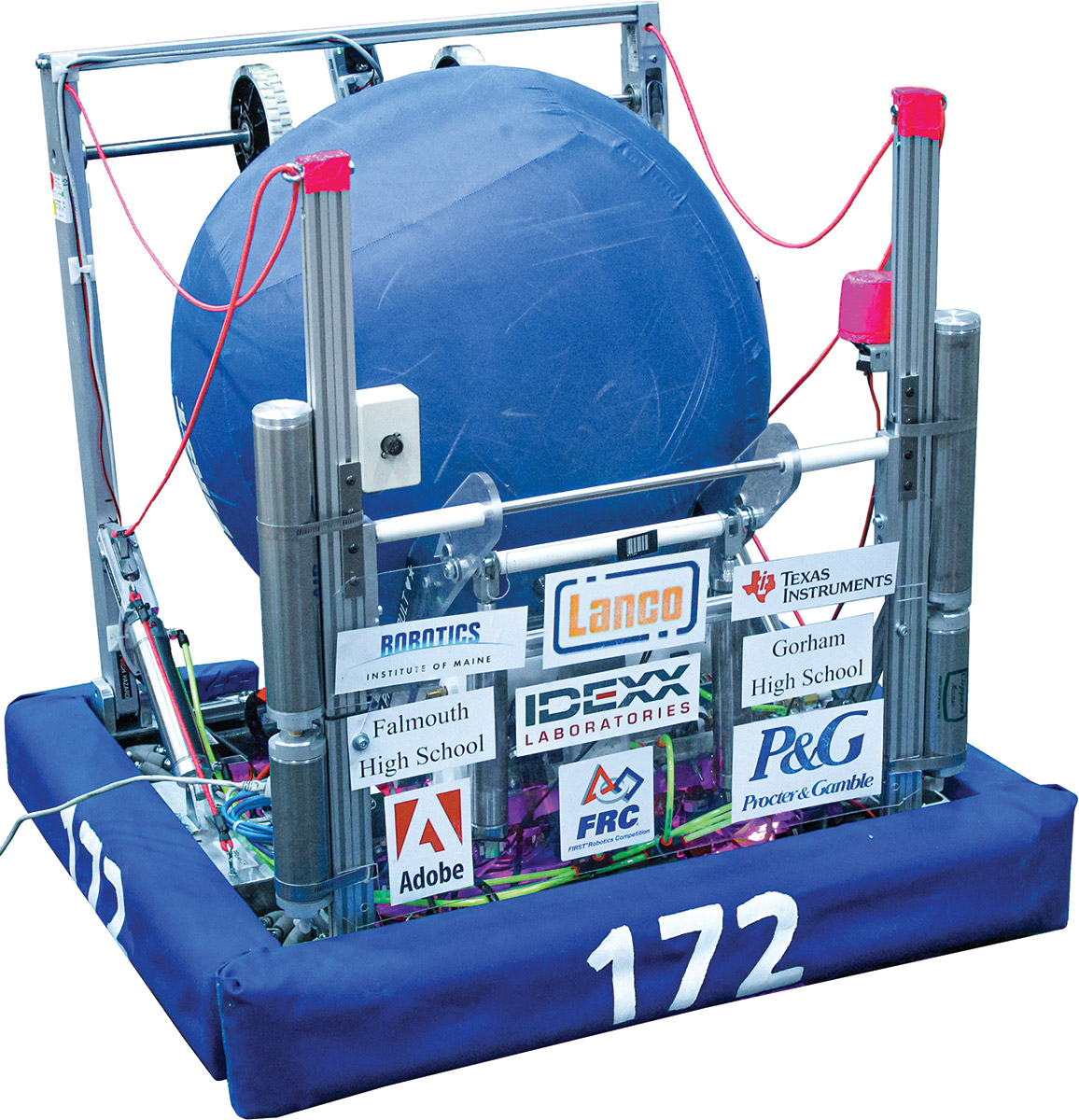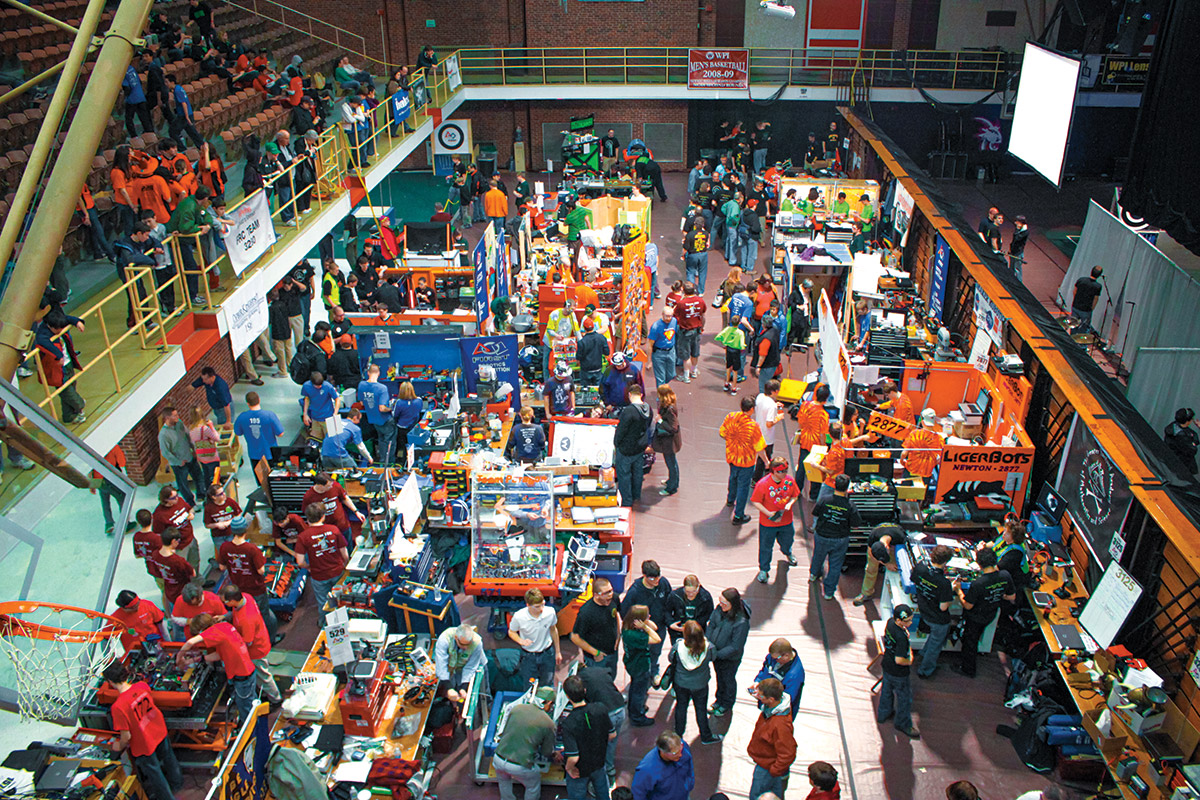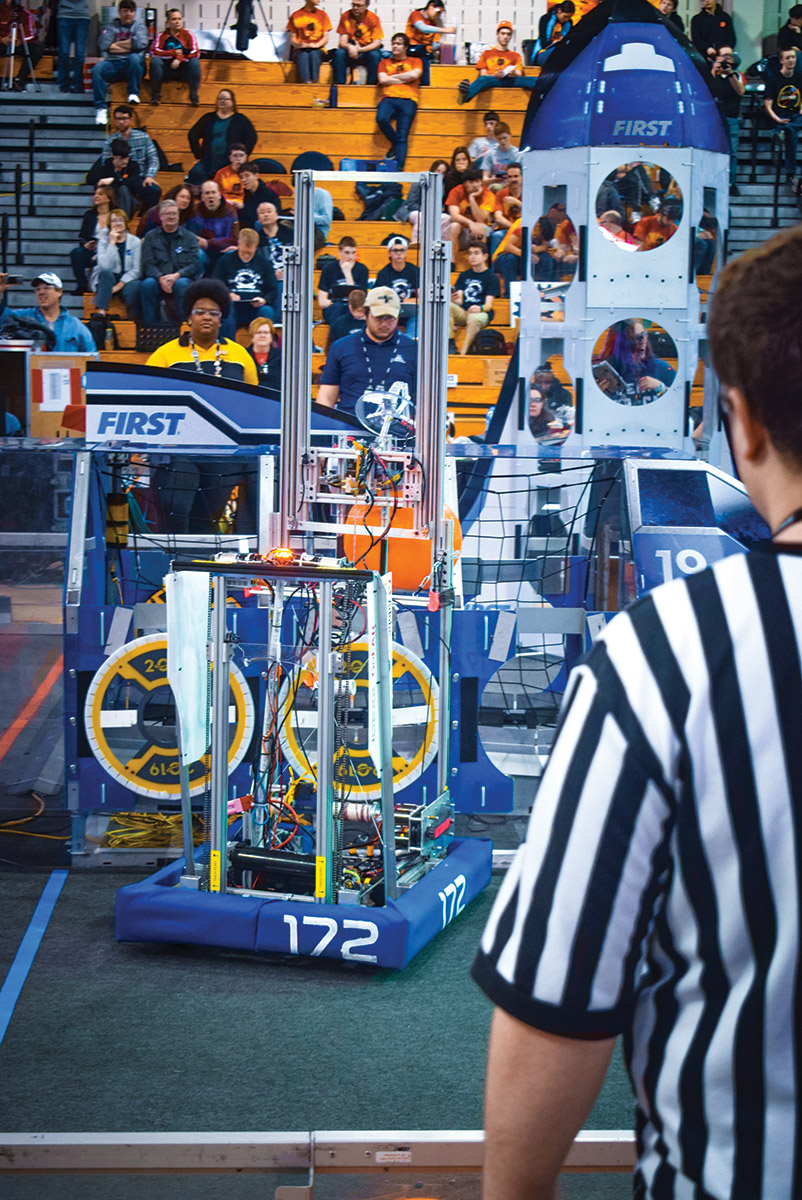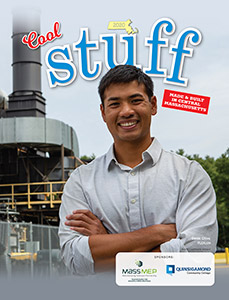Youth competitions bring hands-on STEM learning to life
Annie deCastro didn’t know she’d love robotics as much as she would until she followed her parents’ advice and joined the Northern Force robotics team from Gorham and Falmouth high schools four years ago.
“I thought it would be a bunch of nerdy guys and not a lot of fun,” she says. “I joined my freshman year and I couldn’t have been more wrong.”
Part of a national program known as FIRST (For Inspiration and Recognition of Science and Technology), Northern Force designs and builds robots in competition with teams from elsewhere in the region or from further afield. There’s a different theme every year, like “Deep Space” in 2019 and “Infinite Recharge” planned for 2020.

FIRST Robotics Team 172’s robot for Aerial Assist (2014)
“I went to high school not entirely sure about my career interests. By the end of it, robotics really put me on this path of engineering.”
— Annie deCastro
Falmouth High school 2019 graduate and University of Michigan freshman in mechanical engineering
DeCastro was Northern Force’s captain her junior and senior years at Falmouth High School. Despite the time commitment and having to give up indoor track, deCastro considers robotics her best high school activity by far, and one that helped her decide on a college major. The 2019 high school graduate will study mechanical engineering at the University of Michigan in Ann Arbor.
“I went into high school not entirely sure about my career interests,” she says. “By the end of it, robotics really put me on this path of engineering.”
Getting young people interested in science, technology, engineering and math (STEM), is indeed one of the core goals of robotics, a branch of engineering that involves the conception, design, manufacture and design of robots.
The Robotics Institute of Maine, a nonprofit housed at and administered by the Manufacturers Association of Maine, is dedicated to providing middle and high school students the opportunity to explore robotics in a competitive yet supportive environment.
It does that by working with both the FIRST and VEX robotics competitions to ensure that every Maine student has the opportunity to participate, learn and grow. Every year, it works with thousands of students and hundreds of teachers to expose young Mainers to a hands-on STEM education, including girls who might not otherwise pursue that path.
Nick Stinson, director of design engineering at ON Semiconductor in South Portland and a Robotics Institute board member, says the institute supports robotics programs in two primary ways: by giving grants to help teams defray the costs of programs and by providing financial and logistical support in running statewide competitions that are a critical piece of the whole program.
Though Stinson is not a mentor himself, he has several colleagues who are, and says that one of the motivations behind the company’s involvement is preparing more women for STEM professions.
“The pipeline of available candidates is not very robust, so this is a way to affect that earlier stage,” he says. “If you want to make changes in the workforce, you have to reach kids before they enter college.”
The Northern Force robotics team
embraced 2019’s “Deep Space” theme.
FIRST Robotics vs. VEX Robotics
STUDENTS VEX: 1,000,000 / FIRST: 570,000
TEAMS VEX: 24,000 / FIRST: 67,000
COUNTRIES VEX: 60 / FIRST: 100

An aerial view of the pit area, where teams work on their robots at events.
Corporate support
The Robotics Institute of Maine has some high-profile corporate sponsors, including ON Semiconductor, IDEXX Laboratories Inc. and Texas Instruments. Employees at the companies provide both financial and mentoring support to teams.
Josh Chalmers, an IT and software applications manager with Texas Instruments in South Portland, said he was inspired to get involved with robotics when he started interviewing UMaine engineering students for internships with his firm.
“I started to see a real commonality between strong candidates and a history with their high school robotics programs,” he says. “I was especially impressed by a number of students that carved out time to volunteer with area high school robotics teams. That’s when I knew it had something special.”
Thomas Moutinho, a development process engineer and manager also with Texas Instruments in South Portland, is equally impressed. “It’s a rewarding experience to watch a student’s confidence and technical skill set significantly improve from their freshman to senior year due to the robotics program,” Moutinho says.
ON Semiconductor’s Stinson, who traces his own interest in engineering back to childhood, says he recently hired someone his firm connected with through the robotics program as a design engineer.
“He’s a very independent problem solver and comes with some software skills,”
Stinson says of the new hire. Speaking more generally, Stinson says that students learn important life skills through robotics from problem-solving to how to function as a team to leadership skills and time management.
“They’re practical skills that you learn through experience,” he says. “Robotics programs give students an opportunity to experience an environment they might be exposed to in a real-world environment.”
Origins of two programs
FIRST and VEX have similar objectives but different origins.
FIRST, founded in 1999, is the brainchild of Dean Kamen, an American engineer, inventor and businessman best known for inventing the Segway, a two-wheeled self-balancing personal transporter.
Today, FIRST operates a number of competitions including the international FIRST Robotics Competition for high school students and the FIRST LEGO League for elementary and middle school students.
45,000
robots have been created by FIRST Robotics
$80,000,000
are available for FIRST Robotics scholarships from nearly 200 providers
VEX Robotics is the global division of Innovation First, a global movement that started in a garage in Greenville, Texas, by an electrical engineer named Tony Norman and a mechanical engineer named Bob Mimlitch. Both remain actively involved with VEX, recognized in 2016 by the Guinness Book of World Records as the world’s largest robotics competition.
In the 2018-19 season, there were about 96 registered VEX teams in Maine and about 23 FIRST teams, and close to 1,000 participating students, according to Robotics Institute board member Stinson.
FIRST robotics teams supported by the Robotics Institute of Maine are challenged to raise funds, design a team “brand,” and hone teamwork skills, and get to compete for more than $80 million in college scholarships. Regardless of how they fare, all go home with valuable skills they can use for the rest of their lives.
May the force be with you
Back at Falmouth High School, engineering technology teacher John Kraljic coaches Northern Force, also known as FIRST Robotics Team 172, which lately has had around 40 student members and meets even in summer.
“Our team’s philosophy,” he says, “is more about experience than about winning.”
Professional mentors who work with students include Richard Burt, an application engineer and mechanical engineer at Lanco Integrated in Westbrook, who was on the Northern Force team himself back in high school. As a “hands-on instructional coach” to the team today, he underscores the importance of keeping even the best-intentioned parental interference to a minimum.
“Learning what breaks, and all that kind of stuff, ” he says, “is far more valuable in my opinion than winning the competition or coming up with a cool innovation to change the world.” ◾

A competition robot built by Northern Force robotics team from Gorham and Falmouth high schools.
Find out more
Robotics Institute of Maine » www.robotsinme.org
FIRST Robotics Competition » www.firstinspires.org
VEX Robotics Competition » www.vexrobotics.com
Maine Robotics, Orono » www.mainerobotics.org



